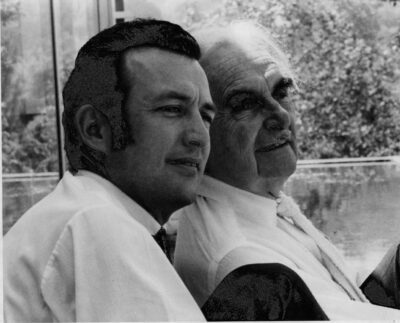Design Profession: Architect
Building Types: Civic, Commercial, Educational, Residential

Richard Neutra was born in 1892, the son of a metallurgist who operated a small, but prosperous foundry in Vienna, Austria. Neutra first became aware of architecture and design during his childhood, where Otto Wagner's designs for Austria's subway stations were an instant attraction to him and would later become a source of inspiration in his own architectural work.
Through his education at the Technische Hochshule in Vienna, Austria, Neutra became more familiar with Wagner's "break from masonry plasticity" and met fellow student Rudolph Schindler, who later played an important role in his career. At the institute Neutra followed the teachings of early Modernist architects like Adolf Loos, whom he viewed as a mentor. Neutra was also exposed to Frank Lloyd Wright's Wasmuth Portfolio; a life-changing experience for him. Upon graduation he intended to travel to Chicago and find a way to meet Wright, but the outbreak of World War I interrupted his plans.
Instead, Neutra spent time in the offices of both Adolf Loos and Gustav Ammann, where he learned about machinist architecture, expressionism, and the importance of site and landscape. However, Neutra's own design philosophy stayed true to his own ideals, which were influenced by Viennese conservatism and biological sciences.
In 1921 Neutra took a job in the Berlin office of architect Erich Mendelsohn. It was while working for Mendelsohn in Germany that Neutra came to the realization that Europe no longer was a friendly atmosphere for Modern architects-the traditionalist views of the Nazi party conflicted with the more leftist-leanings of the Modernist movement. The closure of the Bauhaus in 1933 served as a tipping point; those architects who stayed in Germany conformed to more traditional styles, and those who refused fled or risked imprisonment.
Neutra decided to immigrate to the United States to work in a stable environment where the latest technology in architecture was available. His intention was to join his friend Rudolph Schindler, who was working for Frank Lloyd Wright in Chicago. When Neutra first arrived in New York City in 1924 he stayed to work a few months before moving west. First, Neutra moved to Detroit where he found a position among the large staff at Smith, Hinchman and Grylls; then he went to Chicago in pursuit of Schindler and Frank Lloyd Wright. By then Schindler had moved to Los Angeles to oversee the construction of Wright's Olive Hill and Hollyhock Houses. Neutra secured a job as draftsman for the firm Holabird and Roche where he was disappointed when he discovered that architecture had not progressed past the world's fair, as Louis Sullivan had predicted.
Neutra was able to initiate a meeting with his idol Louis Sullivan before the elder architect's death later that year. It was at Sullivan's funeral that Neutra finally met Frank Lloyd Wright and later traveled to Taliesin in Spring Green, Wisconsin, where he spent a year working in Wright's studio. In 1925 Neutra moved to Los Angeles, California, to finally meet up with Rudolph Schindler. Schindler had designed a duplex on Kings Road and offered the second unit to Neutra. It was in Los Angeles that Neutra came into his own as an architect. He opened his own architectural practice and collaborated with Schindler and urban planner Carol Arnovici, under the firm name of Architectural Group for Industry and Commerce (AGIC).
Southern California proved to be a catalyst for Neutra's burst of creativity, a place where he was finally able to experiment with modern materials and create his own designs based on volume, not mass. His Lovell House, begun in 1927, was hailed by both European and American modernists as a masterpiece and an excellent example of the International style. In 1932 Neutra built his own home and studio in the Silver Lake neighborhood of Los Angeles. Known as the VDL Research House (it was financed by a Dutch businessman, Case H. Van der Leeuw (VDL)), it was meant to demonstrate that the design principles applied to the homes of affluent clients like the Lovells could also be applied to a typical middle class family home. Neutra's work in Los Angeles was included in Philip Johnson's seminal exhibition Modern Architecture at the Museum of Modern Art in New York City in 1932, which brought him national attention.
During the 1930s, Neutra began obtaining more commercial commissions, including restaurants and offices as well as public and government buildings. Neutra had a particular interest in designing apartment complexes, and he designed a number of them in Los Angeles in the late 1930s, including the Jardinere and Landfair Apartments. The Strathmore Apartments, designed in 1946, became home to designers Charles and Ray Eames and the editor of Arts and Architecture magazine, John Entenza. Toward the end of the Great Depression, Neutra began working with federal relief programs, such as the National Youth Administration and the Works Progress Administration, to develop public housing in Los Angeles. One of his most respected designs was the Channel Heights development for shipyard workers.
Neutra's success continued after World War II. The Kaufmann Desert House in Palm Springs, built in 1946 for Edward Kaufman Jr., the owner of Frank Lloyd Wright's Fallingwater, is considered an important example of the International style.
Richard Neutra was one of the pioneering architects that first brought Modernism and the International style to Southern California. His work is found all across the country from Oregon to Texas. The only known example of Neutra's work in Michigan is the List House in Grand Rapids. A modest home, it shows traits indicative of Neutra's design aesthetic as demonstrated in the VDL Research House and the Davey House, both in California.
